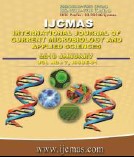


 National Academy of Agricultural Sciences (NAAS)
National Academy of Agricultural Sciences (NAAS)

|
PRINT ISSN : 2319-7692
Online ISSN : 2319-7706 Issues : 12 per year Publisher : Excellent Publishers Email : editorijcmas@gmail.com / submit@ijcmas.com Editor-in-chief: Dr.M.Prakash Index Copernicus ICV 2018: 95.39 NAAS RATING 2020: 5.38 |
Short-term (after 3 crop cycle) field experiment was conducted to assess the effect of three tillage systems no tillage (NT), reduced tillage (RT) and conventional tillage (CT) and four crop rotations were selected, soybean + P. pea (S + PP, 2:1), soybean- wheat (S-W), maize + P. pea (M + PP, 1:1) and maize- gram (M - G) with their residue management (residue retained vs. burnt) on soil organic carbon fractions were study in a black soils (Vertisols) of Central India. Change in soil organic fractions influence in soil quality, health and carbon sequestration. Pools of soil organic matter (SOM) fractions (4 fractions) of carbon, very labile (VL), labile (L), less labile (LL) and non-labile (NL) return the status and composition of soil organic carbon at different (0-5, 5-15, 15-30 and 30-45 cm) depths and have implications for the change and retention of SOC. Our aims of study to determine how three tillage practices and four cropping systems (CS) with residue management, affected soil organic carbon after third crop cycle. The results revealed that RT (0.42, 0.19 & 0.19 %) was significantly the highest soil organic carbon followed by NT (0.41, 0.17 & 0.17 %) than CT (0.35,0.13 & 0.14 %) especially, VLC, LC and LLC fractions in 0-5 cm depth and NLC fraction recorded the highest in NT (0.46 %) as compared to RT (0.42 %) than CT (0.40 %). However, in case of 5-15 cm depth NT was found significantly the highest organic carbon fraction (VL, L, LL & NL) followed by RT than CT. The lower depths (15-30 and 30-45 cm) found NLC > VLC > LC similar trend but, LLC was higher than 15-30 cm depth respectively. The result reveled that S-W (0.44 %) and M-G (0.42 %) based cropping system have the highest SOC in RT than NT S-W (0.43 %) and M-G (0.43 %), and in CT, S+PP (0.38 %) and M+PP (0.37 %) was found higher SOC fraction.
 |
 |
 |
 |
 |